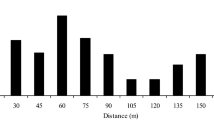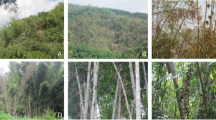Abstract
Understanding the variation of mating patterns in disturbed habitats provide insight into the evolutionary potential of plant species and how they persist over time. However, this phenomenon is poorly understood in tropical dryland tree species. In the present study, we investigated how Acacia senegal reproduces in two different environmental contexts in Kenya. Open-pollinated progeny arrays of 10 maternal trees from each environmental context were genotyped using 12 nuclear microsatellite markers. Overall, A. senegal displayed a predominantly allogamous mating pattern. However, higher multilocus outcrossing rate (tm) was found in Lake Bogoria (tm = 1.00) than in Kampi ya Moto population (tm = 0.949). Higher biparental inbreeding (t m − t s = 0.116) and correlation of outcrossed paternity (rp = 0.329) was found in Kampi ya Moto than in Lake Bogoria population (t m − t s = 0.074, rp = 0.055), showing the occurrence of mating among relatives. Coefficient of coancestry (Θ = 0.208) showed that full-sibs constitute about 21% of the offspring in Kampi ya Moto population compared to about 14% (Θ = 0.136) in Lake Bogoria population. The results demonstrate that low adult tree density of A. senegal may be promoting seed production through consanguineous mating and suggest that man-made disturbance can affect mating patterns of the species. Despite these mating differences, trees from both populations can contribute as seed source for conservational plans, and to support effective genetic conservation and artificial regeneration programs of A. senegal. We suggest collection of seeds from at least 42 and 63 trees in Lake Bogoria and Kampi ya Moto populations, respectively, to retain a progeny array with a total effective population size of 150.
Similar content being viewed by others
References
Aguilar R, Quesada M, Ashworth L, Herrerias-Diego Y, Lobo J (2008) Genetic consequences of habitat fragmentation in plant populations: susceptible signals in plant traits and methodological approaches. Mol Ecol 17:5177–5188. doi:10.1111/j.1365-294X.2008.03971.x
Alves RM, Artero AS, Sebbenn AM, Figueira A (2003) Mating system in natural populations of Theobroma grandiflorum (Willd. ex. Spreng.) Schum., by microsatellite markers. Genet Mol Biol 26:373–379. Mol Ecol 17: 5177–5188. doi:10.1590/S1415-4757200300030002
Baringo County Government (2014) Annual development plan 2015/16. Government printers, Nairobi
Beardmore J (1983) Extinction, survival, and genetic variation. In: Schonewald-Cox CM, Chambers SM, MacBryde F, Thomas L (eds) Genetics and conservation: a reference for managing wild animal and plant populations. Benjamin/Cummings, Menlo Park, pp 125–151
Boshier DH, Chase MR, Bawa KS (1995) Population genetics of Cordia alliodora (Boraginaceae), a Neotropical tree, mating system. Am J Bot 82:476–483
Casiva P, Vilardi J, Cialdella A, Saidman B (2004) Mating system and population structure of Acacia aroma and A. macracantha (Fabaceae). Am J Bot 91:58–64. doi:10.3732/ajb.91.1.52
Chikamai BN, Odera JA (2002) Commercial plant gums and resins in Kenya. Nairobi, Kenya
Cockerham CC (1969) Variance of gene frequencies. Evolution 23:72–84
Collevatti RG, Grattapaglia D, Hay JD (2001) High resolution microsatellite based analysis of the mating system allows the detection of significant bi-parental inbreeding in Caryocar brasiliense, an endangered tropical tree species. Heredity 86:60–67. doi:10.1046/j.1365-2540.2001.00801
Davies SJ, Cavers S, Finegan B, White A, Breed MF, Lowe AJ (2015) Pollen flow in fragmented landscapes maintains genetic diversity following stand-replacing disturbance in a neotropical pioneer tree, Vochysia ferruginea Mart. Heredity 115:125–129
de-Lucas AI, Robledo-Arnuncio JJ, Hidalgo E, González-Martínez SC (2008) Mating system and pollen gene flow in Mediterranean maritime pine. Heredity 100:390–399. doi:10.1038/sj.hdy.6801090
Diallo I, Samb PI, Gaye A, Sall PN, Duhoux E, Ba AT (1997) Floral biology and pollination in Acacia senegal (L.) Willd. Biologie florale et pollinisation chez Acacia senegal (L.) Willd. Bot Lett 144(1):73–82. doi:10.1080/12538078.1997.10515755
Diallo AM, Nielsen LR, Hansen JK, Ræbild A, Kjær ED (2015) Study of quantitative genetics of gum arabic production complicated by variability in ploidy level of Acacia senegal (L.) Willd. Tree Genet Genomes 11:80–92. doi:10.1007/s11295-015-0902
Dick CW, Etchelecu G, Usterlitz FA (2003) Pollen dispersal of tropical trees (Dinizia excelsa: Fabaceae) by native insects and African honeybees in pristine and fragmented Amazonian rainforest. Mol Ecol 12:753–764. doi:10.1046/j.1365-294X.2003.01760
Duminil J, Abessolo MDT, Bourobou DN, Doucet J-L, Loo J, Hardy OJ (2016) High selfing rate, limited pollen dispersal and inbreeding depression in the emblematic African rain forest tree Baillonella toxisperma—management implications. For Ecol Manag 379:20–29
Eckert CG, Kalisz S, Geber MA, Sargent R, Elle E, Cheptou PO, Goodwillie C, Johnston MO, Kelly JK, Moeller DA, Porcher E, Ree RH, Vallejo-Marín M, Winn AA (2010) Plant mating systems in a changing world. Trends Ecol Evol 25:35–43. doi:10.1016/j.tree.2009.06.013
Ellstrand NC, Ellam RD (1993) Population genetic consequences of small population size: implications for plant conservation. Annu Rev Ecol Syst 24:217–242. doi:10.1146/annurev.es.24.110193.001245
Fagg CW, Allison GE (2004) Acacia senegal and gum arabic trade: monographs and annotated bibliography. Tropical forestry papers. No. 42. Oxford Forestry Institute, Oxford, UK
Feres JM, Sebbenn AM, Guidugli MC, Mestriner MA, Moraes MLT, Alzate–Marin AL (2012) Mating system parameters at hierarchical levels of fruits, individuals and populations in the Brazilian insect—pollinated tropical tree, Tabebuia roseo–alba (Bignoniaceae). Conserv Genet 13:393–405. doi:10.1007/s10592-011-0292-z
Franceschinelli EV, Bawa KS (2000) The effect of ecological factors on the mating system of a South American shrub species (Helicteres brevispira). Heredity 84:116–123. doi:10.1046/j.1365-2540.2000.00636.x
Frankham R, Ballou JD, Eldridge MDB, Lacy RC, Ralls K, Dudash MR, Fenster CB (2011) Predicting the probability of outbreeding depression. Conserv Biol 25:465–475. doi:10.1111/j.1523-1739.2011.01662.x
Fuchs E, Lobo JA, Quesada M (2003) Effects of forest fragmentation and flowering phenology on the reproductive success and mating patterns on the tropical dry forest tree, Pachira quinata (Bombacaceae). Conserv Biol 17:149–157. doi:10.1046/j.1523-1739.2003.01140.x
Hall P, Walker S, Bawa K (1996) Effect of forest fragmentation on genetic diversity and mating system in a tropical tree, Pithecellobium elegans. Conserv Biol 10:757–768. doi:10.1046/j.1523-1739.1996.10030757.x
Hanaoka S, Omondi SF, Machua J (2013) Basic molecular techniques for tree breeding—experimental protocols. Sankeisha co. ltd, Aichi
Hedrick PW (2005) A standardized genetic differentiation measure. Evolution 8:1633–1638
Jacquemyn H, De Meester L, Jongejans E, Honnay O (2012) Evolutionary changes in plant reproductive traits following habitat fragmentation and their consequences for population fitness. J Ecol 100:76–87. doi:10.1111/j.1365-2745.2011.01919.x
Karasawa MM, Vencovsky R, Silva CM, Zucchi MI, Oliveira GC, Veasey EA (2007) Mating system of Brazilian Oryza glumaepatula populations studied with microsatellite markers. Ann Bot 99:245–253. doi:10.1093/aob/mcl248
Khasa DP, Cheliak WM, Bousquet J (1993) Mating system of Racosperma auriculiforme in a seed production area in Zaire. Can J Bot 71:779–785. doi:10.1139/b93-089
Kikuchi S, Shibata M, Tanaka H (2015) Effects of forest fragmentation on the mating system of a cool-temperate heterodichogamous tree Acer mono. Glob Ecol Conserv 3(2015):789–801. doi:10.1016/j.gecco.2015.04.005
Lacerda EBL, Kanashiro M, Sebbenn AM (2008) Long-pollen movement and deviation of random mating in a low-density continuous population of Hymenaea courbaril in the Brazilian Amazon. Biotropica 40:462–470
Lander TA, Bebber DP, Choy CTL, Harris SA, Boshier DH (2011) The circe principle explains how resource-rich land can waylay pollinators in fragmented landscapes. Curr Biol 21(15):1302–1307
Lee SL, Wickneswari R, Mahani MC, Zakri AH (2000) Mating system parameters in a tropical tree species, Shorea leprosula Miq. (Dipterocarpaceae), from Malaysian lowland dipterocarp forest. Biotropica 32(4):693–702. doi:10.1111/j.1744-7429.2000.tb00517.x
Lemes MR, Grattapaglia D, Grogan J, Proctor J, Gribel R (2007) Flexible mating system in a logged population of Swietenia macrophylla Kind (Meliaceae): implication for the management of threatened neotropical tree species. Plant Ecol 192:169–179. doi:10.1007/s11258-007-9322-9
Liengsiri C, Boyle TJB, Yeh FC (1998) Mating system in Pterocarpus macrocarpus Kurz in Thailand. J Hered 89:216–221. doi:10.1093/jhered/89.3.216
Lowe AJ, Boshier D, Ward M, Bacles CFE, Navarro C (2005) Genetic resource impacts of habitat loss and degradation; reconciling empirical evidence and predicted theory for Neotropical trees. Heredity 95:255–273. doi:10.1038/sj.hdy.6800725
Millar M, Coates D, Byrne M (2014) Extensive long-distance pollen dispersal and highly outcrossed mating in historically small and disjunct populations of Acacia woodmaniorum (Fabaceae), a rare banded iron formation endemic. Ann Bot 114(5):961–971. doi:10.1093/aob/mcu167
Mimura M, Barbour RC, Potts BM (2009) Comparison of contemporary mating patterns in continuous and fragmented Eucalyptus globulus native forests. Mol Ecol 18:4180–4192. doi:10.1111/j.1365-294X.2009.04350.x
Murawski DA, Hamrick JL (1992) The mating systems of Cavanillesia platanifolia under extremes of flowering-tree density: a test of predictions. Biotropica 24:99–101. doi:10.2307/2388478
Obunga EO (1995) A study of genetic systems of four African species of Acacia. Dissertation, University of Sussex
Omondi FS, Kireger E, Dangasuk GO, Chikamai B, Odee DW, Cavers S, Khasa DP (2010) Genetic diversity and population structure of Acacia senegal (L) Willd. in Kenya. Trop Plant Biol 3:59–70. doi:10.1007/s12042-009-9037-2
Omondi SF, Ongamo GO, Kanya JI, Odee DW, Khasa DP (2016a) Genetic consequences of anthropogenic disturbances and population fragmentation in Acacia senegal. Conserv Genet. doi:10.1007/s10592-016-0854-1
Omondi SF, Ongamo GO, Kanya JI, Odee DW and Khasa DP (2016b) Synchrony in leafing, flowering and fruiting phenology of Senegalia senegal within Lake Baringo woodland, Kenya: Implication for conservation and tree improvement. Int J For Res 2016, Article ID 6904834
Ritland K (1989) Correlated matings in the partial selfer Mimulus guttatus. Evolution 43:848–859
Ritland K (1996) Multilocus mating system program (MLTR). Version1.1. Department of Botany, University of Toronto, Toronto
Ritland K (2002) Extensions of models for the estimation of mating systems using n independent loci. Heredity 88:221–228. doi:10.1038/sj.hdy.6800029
Ritland K, Jain SK (1981) A model for estimation of outcrossing rate and gene frequencies using independent loci. Heredity 47:35–52. doi:10.1038/hdy.1981.57
Sebbenn AM (2006) Sistemas de reprodução em espécies tropicais e suas implicações para a seleção de árvores matrizes para reflorestamentos ambientais. In: Higa AR, Silva LD (eds) Pomar de sementes de espécies florestais nativas. FUPEF do Paraná, Curitiba, pp 93–138
Sebbenn AM, Seoane CEC, Kageyama PY, Lacerta CM (2001) Estrutura genética em populações de Tabebuia cassiroides: implicações para o manejo florestal e conservação genética. Revista do Instituto Florestal 13:99–111
Seoane CEC, Sebbenn AM, Kageyama PY (2001) Sistema reprodutivo em populações de Esenbeckia leiocarpa. Revista do Instituto Florestal 13:21–28
Suarez-Gonzalez A (2011) Reproductive and genetic consequences of fragmentation in chokecherry (Prunus virginiana L.). Dissertation, University of Winnipeg
Sun M, Ritland K (1998) Mating system of yellow starthistle (Centaurea solstitialis), a successful colonizer in North America. Heredity 80:225–232. doi:10.1046/j.1365-2540.1998.00290.x
Tamaki I, Ishida K, Setsuko S, Tomaru N (2009) Inter-population variation in mating system and late-stage inbreeding depression in Magnolia stellata. Mol Ecol 18:2365–2374. doi:10.1111/j.1365-294X.2009.04195.x
Tambarussi EV, Boshier DH, Vencovsky R, Freitas MLM, Di-Dio OJ, Sebbenn AM (2016) Several small: how inbreeding affects conservation of Cariniana legalis Mart. Kuntze (Lecythidaceae) the Brazilian Atlantic Forest’s largest tree. Int For Rev 18(4):502–510
Tandon R, Shivanna KR (2001) Pollination biology and breeding system of Acacia senegal. Bot J Linean Soc 135:251–262. doi:10.1111/j.1095-8339.2001.tb01094.x
Tybirk K (1997) Reproductive biology and evolution of the genus Acacia. Bull Int Gr Study Mimosoideae 20:45–53
Ward M, Dick CW, Gribel R, Lowe AJ (2005) To self, or not to self. A review of outcrossing and pollen-mediated gene flow in neotropical trees. Heredity 95:246–254. doi:10.1038/sj.hdy.6800712
Wekesa C, Makenzi PM, Chikamai BN, Luvanda AM, Muga MO (2010) Traditional ecological knowledge associated with Acacia senegal (gum arabic tree) management and gum arabic production in northern Kenya. Int For Rev 12(3):240–246
White TL, Adams WT, Neale DB (2007) Forest genetics. CAB international, Oxfordshire
Young AG, Boyle T, Brown ADH (1996) The population genetic consequences of habitat fragmentation for plants. Trends Ecol Evol 11:413–418. doi:10.1016/0169-5347(96)10045-8
Acknowledgements
This study was funded by Kenya Forestry Research Institute (KEFRI) and the International Foundation for Science (IFS), Stockholm, Sweden, through a grant to Stephen F. Omondi Grant No. D5452-1. Natural Sciences and Engineering Research Council of Canada (NSERC) Discovery grant to Prof. Damase P. Khasa towards the study is acknowledged. We are grateful to Biotechnology Laboratory staff of KEFRI for helping during field sampling and laboratory analyses.
Author information
Authors and Affiliations
Corresponding author
Ethics declarations
Conflict of interest
The authors declare that they have no conflict of interest.
Rights and permissions
About this article
Cite this article
Omondi, S.F., Odee, D.W., Ongamo, G.O. et al. Mating patterns of the gum arabic tree (Acacia senegal synonym Senegalia senegal) in two different habitats. New Forests 49, 53–65 (2018). https://doi.org/10.1007/s11056-017-9604-6
Received:
Accepted:
Published:
Issue Date:
DOI: https://doi.org/10.1007/s11056-017-9604-6




